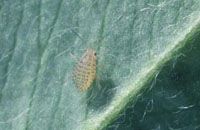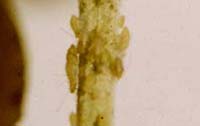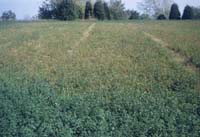Spotted Alfalfa Aphid
Therioaphis maculata Buckton

Figure 1. Spotted Alfalfa Aphid on Leaf
Description
The mature aphid is about 1/16 inch long, and
is either winged or wingless. It is yellow and has several rows of black
or brown spots on its back and on the underside of its body. The young,
or nymphs, resemble the adults,but are smaller and have no wings. When
magnified, they appear spiny. Usually, spotted alfalfa aphids are most
abundant on the lower part of the plant.
A sugary secretion of aphids, called honeydew, is often apparent in moderately to heavily infested fields. A black, sooty mold may develop on the honeydew. Apparently this aphid feeds almost exclusively on alfalfa and does not attack any of our other forage crops. However, two other species of aphids closely resemble it--the yellow clover aphid on red clover and the sweet clover aphid on sweet clover. These two do not become established on alfalfa. Therefore, an aphid fitting this description on alfalfa is likely to be the spotted alfalfa aphid, while that found on red, alsike, or sweet clover is not the spotted alfalfa aphid.

Figure 2. Spotted Alfalfa
Aphids on Alfalfa Stem
Life Cycle
Spotted alfalfa aphids winter primarily in the
adult stage in the crown of the alfalfa plant, feeding whenever the
weather permits. They begin to produce young early in the spring. Since
no male spotted alfalfa aphids have been observed in the United States
to date, every spotted alfalfa aphid is assumed to be a female capable
of giving birth to living young, at the rate of 1 to 6 a day under
optimum conditions.
Each adult may produce 25 to 100 young in her life span. Depending on temperatures, it takes 1 to 4 weeks for a nymph to mature; thus, there may be 15 to 30 generations each year. This pest was first found in the United States in 1954, spreading since into 32 states. It flies readily from field to field; it can migrate long distances in strong winds. This migratory ability may be important to Illinois alfalfa growers. The aphid apparently did not survive in Illinois in the winter of 1956-1957; therefore, future infestations evidently must come from migratory flights.

Figure 3. Severe Damage in Alfalfa
Field from Spotted Alfalfa Aphid
Damage
In the early stages of an infestation, the plants
begin to wilt; healthy green plants begin to yellow and turn brown. This
damage usually appears first in a small area that gradually enlarges,
causing many plants to die. Thus, old stands are seriously thinned and
the life of the crop is shortened. Death or serious damage to
established stands occurs most often when moisture is scarce.
Moderate to heavy infestations of the spotted aphid seriously reduce hay quality and yields. New alfalfa seedings are killed rapidly. The honeydew secreted by the aphids may become sothick that cutter bars on mowers gum up and have to be washed. Balers may have to be washed to keep them operating. In severe cases, tractor tires become covered with the sticky material and must be washed. A sooty mold that develops on the honeydew seriously affects the quality of the hay. One aphid per seedling will produce enough young in 7 to 10 lays Lo kill the tiny plant. An infestation of 20 aphids per stem in old stands of alfalfa may develop into a very serious infestation within 1 to 2 weeks.
Control
Natural or biological control is quite important.
Several species of lady beetles and their young feed on aphids. It has
been said that a lady beetle is capable of eating a teaspoonful of
aphids in one day. The young of the green lacewing, or aphids lions, as
well as the larvae of flower flies, also feed extensively on aphids.
Several other insects also prey on these pests. Species of wasps,
specific parasites of the spotted alfalfa aphid, have been imported from
the insect's native home and are now becoming established in the United
States. Whether some of our native parasitic insects will attack this
pest remains to be seen. Naturally occurring fungus diseases of aphids
may help to control it. Winter weather, as it affects the ability of the
aphid to overwinter, is important in determining how numerous this pest
will be. Rainstorms during the growing season may also have an effect.
Humidity may be a factor in Illinois, since the insect appears to thrive
best under dry conditions and moderate temperatures. Unfortunately,
these natural factors are often not able to cope with heavy infestations
of this pest before serious damage or loss of stand occurs. In these
cases, chemical control will be helpful. Since these aphids migrate
readily, chemical control operations must be a community endeavor. In
applying chemical control measures, however, always evaluate the
populations of beneficial insects. If they seem to be numerous, the use
of chemicals may be unwise. On the other hand, if such pests are scarce
or absent, chemical control may be advantageous.